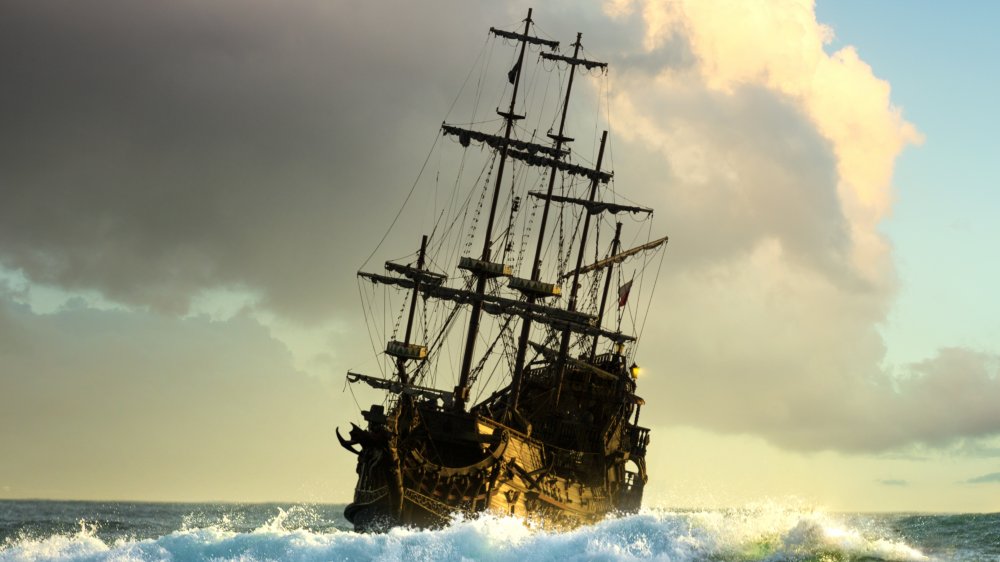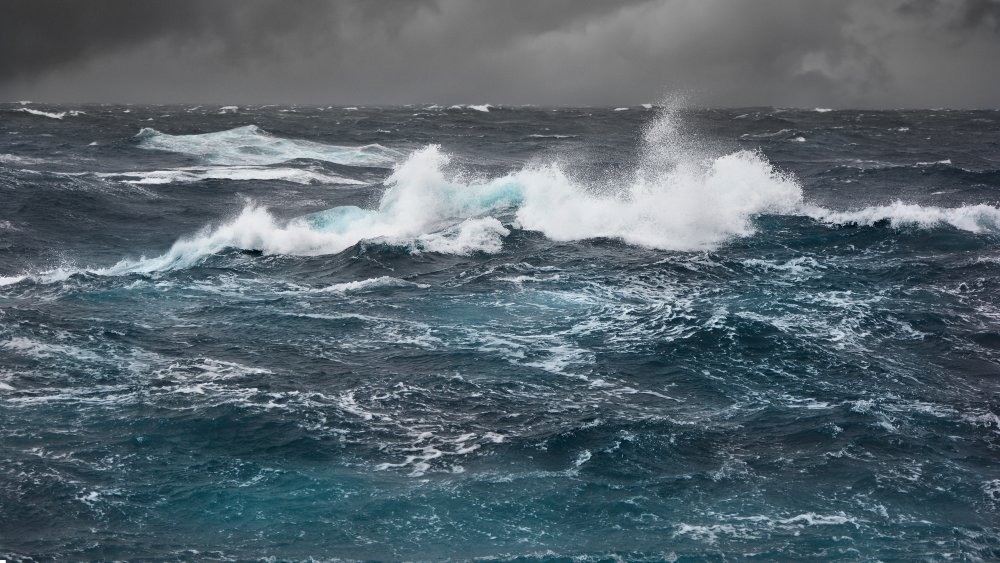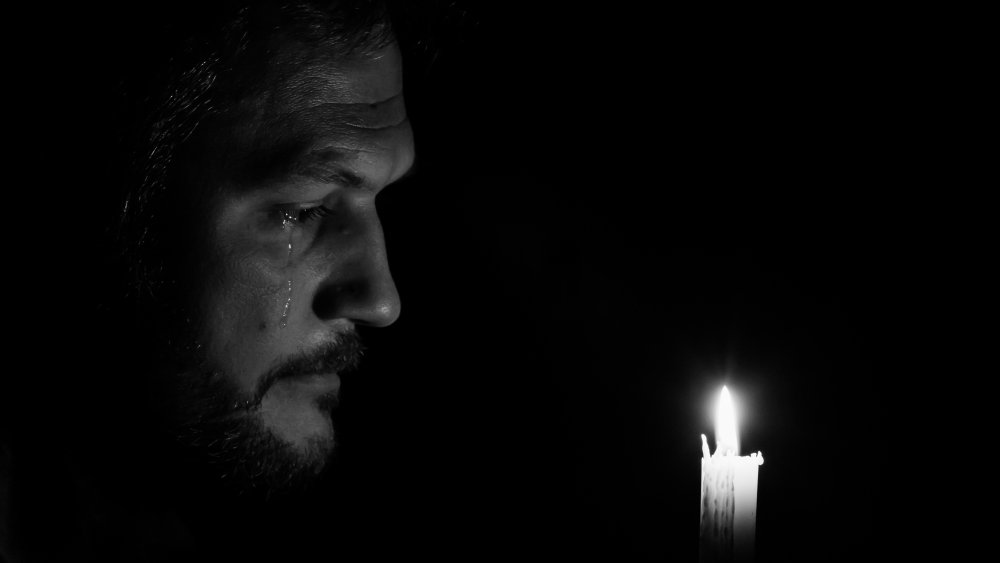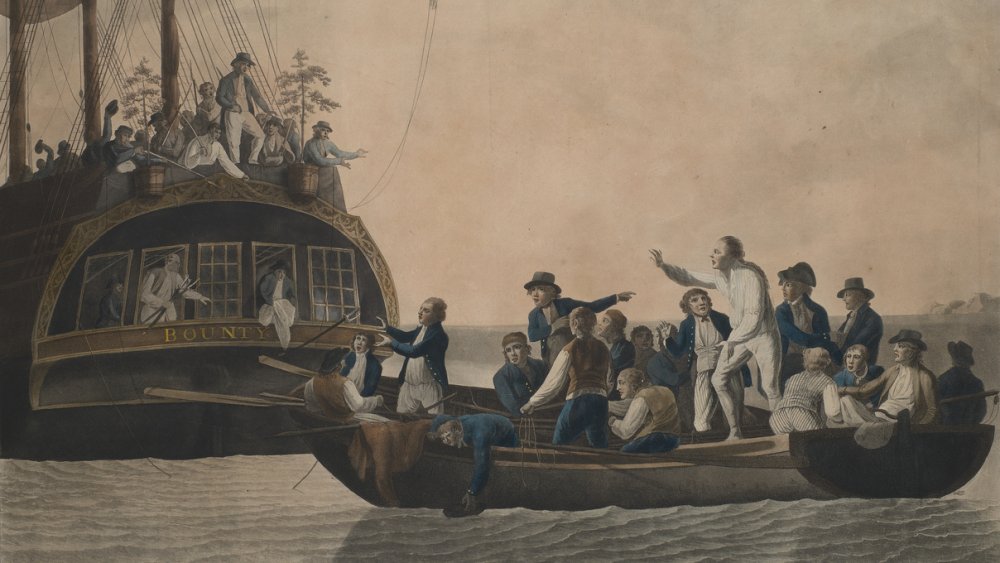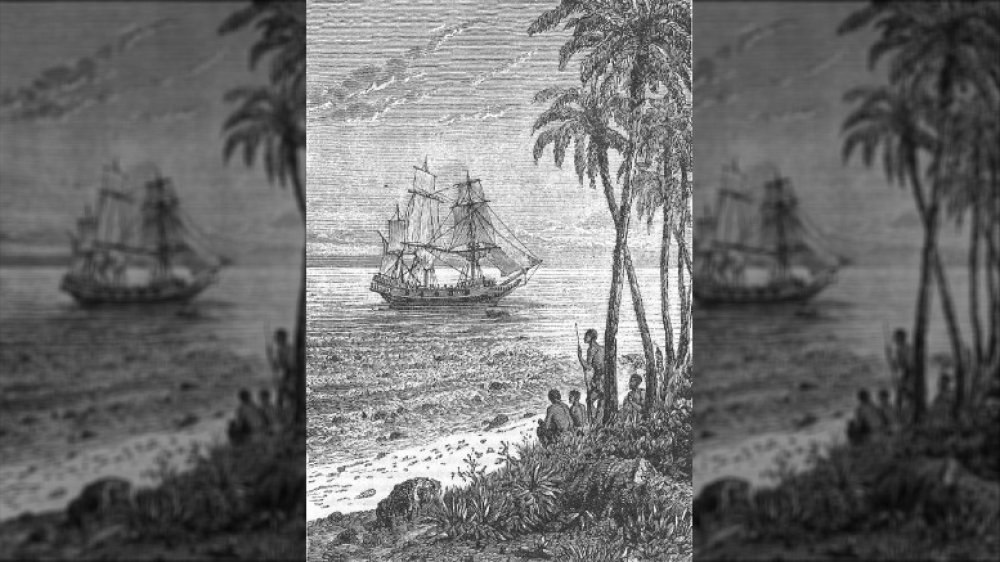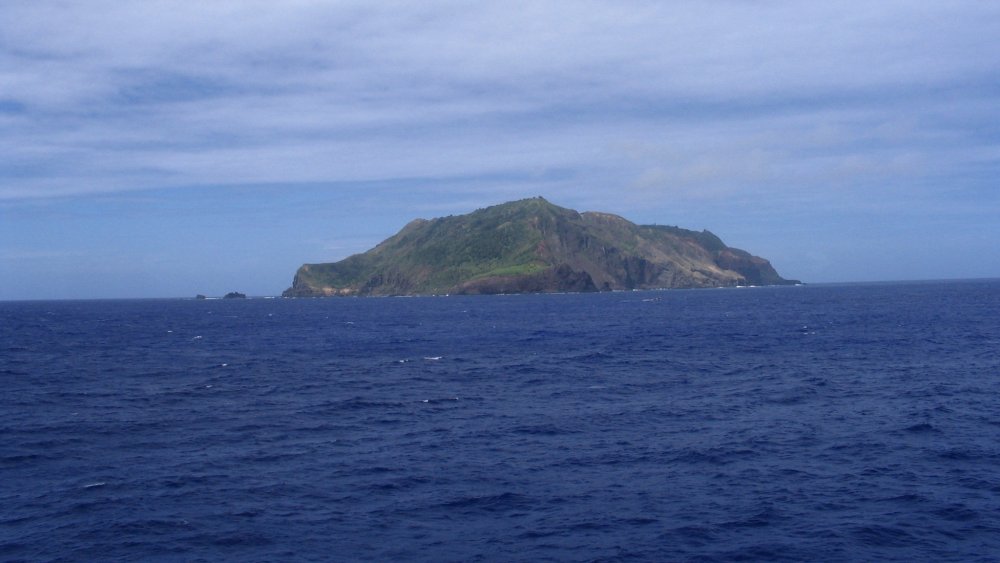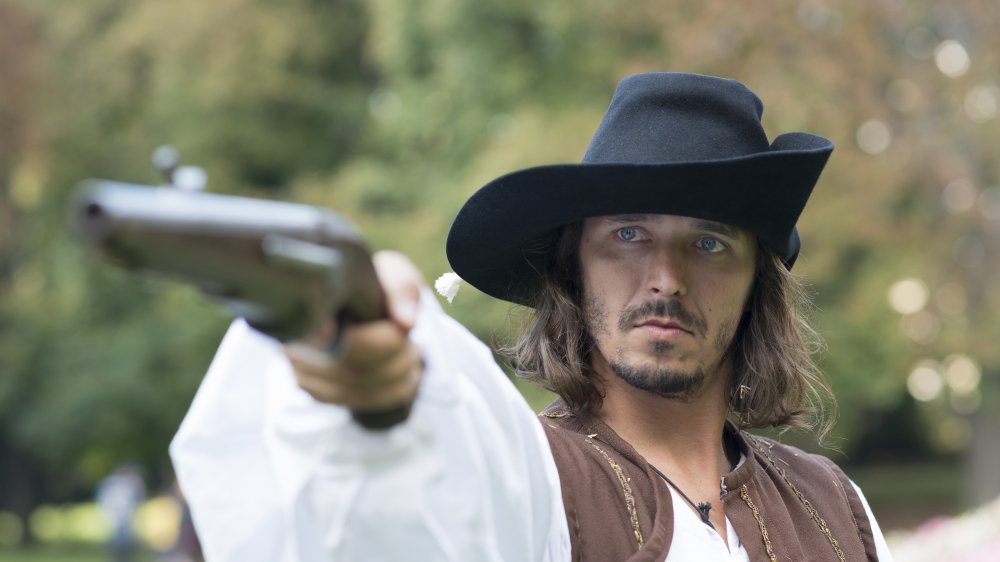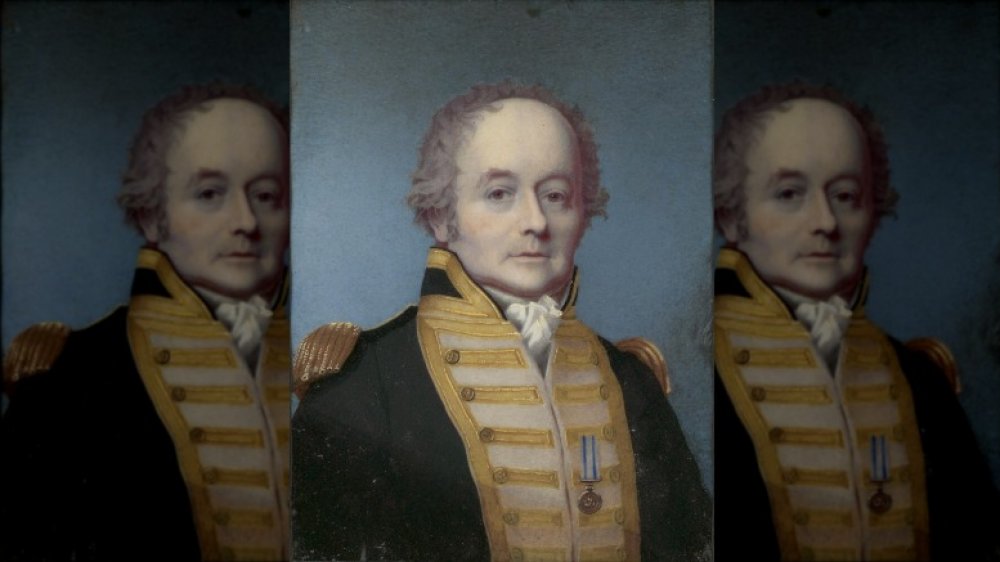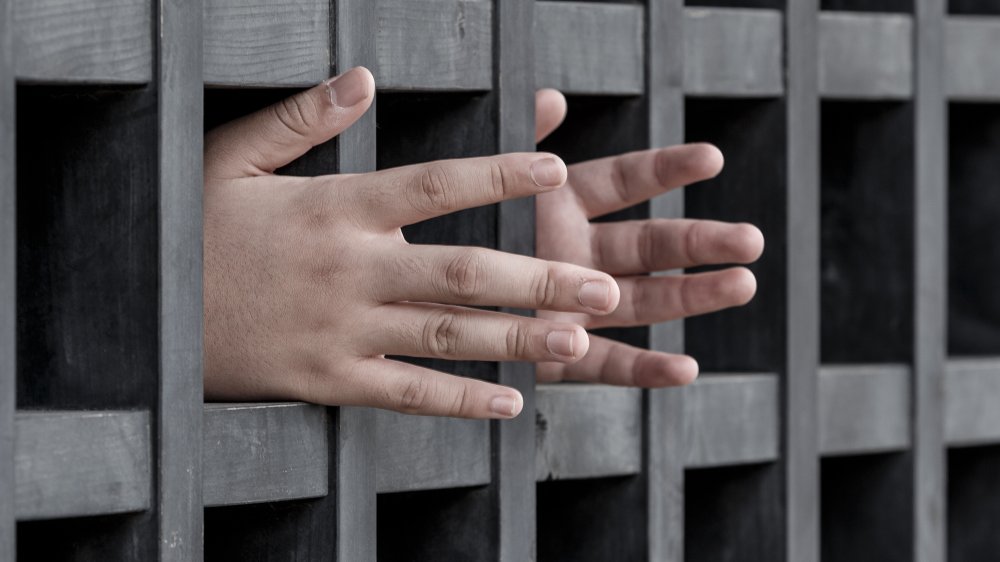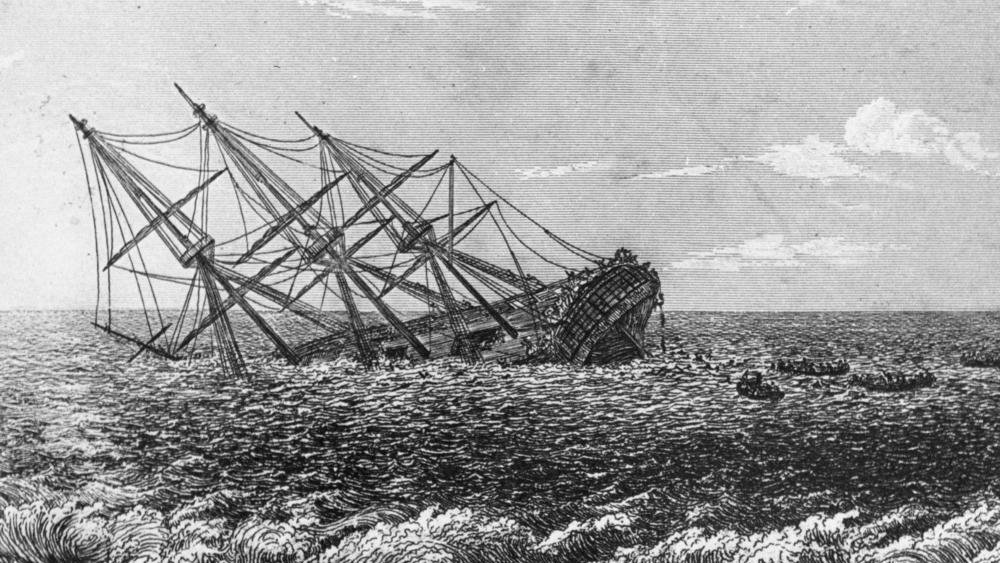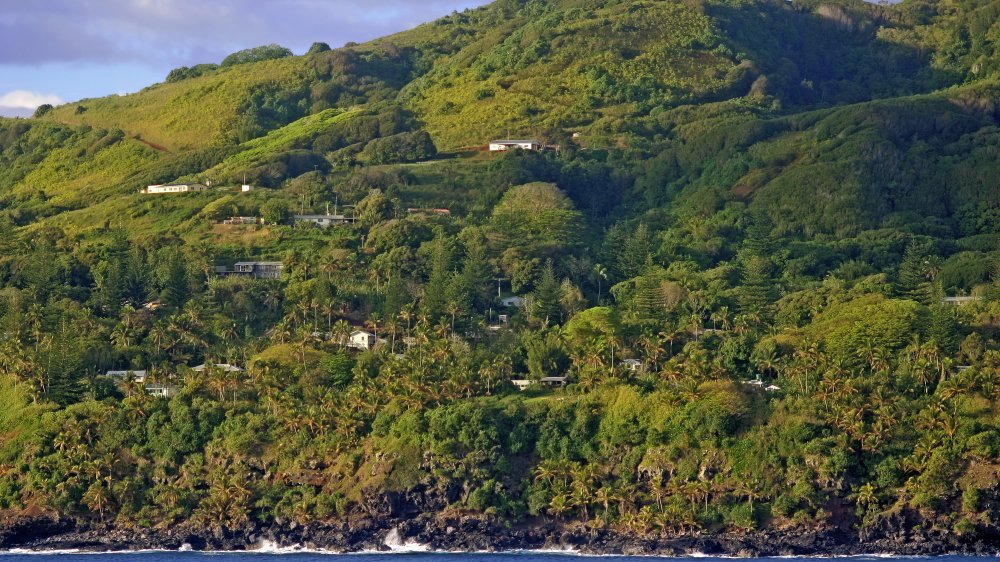The Crazy Real-Life Story Of The Mutiny On The Bounty
When it comes to famous instances of tossing the boss out in his underwear, it doesn't get any crazier than the mutiny on the HMS Bounty. The basic story is fairly well-known. On a return voyage from Tahiti, the tyrannical actions of commanding officer Lieutenant William Bligh pushed his crew to revolt, cast Bligh to the seas, and strike out on their own. The mutiny's leader, Fletcher Christian, has been portrayed by big names like Clark Gable and Marlon Brando as a hero motivated by love found on Tahiti and concern for his crewmates.
As is often the case, though, the truth is hazier, and the story of the mutiny on the Bounty more befits an HBO prestige drama than a silver-screen romance. Heroes were hard to come by, ship-stealing in no way prepares one for starting their own government, and the whole affair was full of details that you would've never heard in grade school. Here's the crazy, real-life version of the mutiny on the Bounty.
The Bounty's initial voyage to Tahiti was no picnic
After the United States won its independence, England found itself short on American fish exports. According to Professor Douglas O. Linder's website Famous Trials, the English turned to breadfruit, a plant which had been discovered in Tahiti in 1769 by Captain James Cook, to feed their slaves in the Lesser Antilles and Jamaica. In 1787, Lieutenant William Bligh was selected to command the Bounty, with its mission to sail to Tahiti and acquire breadfruit plants. The first crewman he recruited was Fletcher Christian, a friend with whom he'd sailed before.
The Bounty left England on December 23, 1787, on a course for Tahiti around the southern tip of South America. As they neared Cape Horn in March, the weather turned atrocious, with wave after wave battering the ship. Bligh had no choice but to steer the Bounty on a 10,000-mile detour past Africa and Australia.
Amazingly, no trouble with the crew was noted until they'd reached Tasmania's Adventure Bay in late August. There, Bligh had words for the ship's carpenter, William Purcell. Bligh insulted Purcell's workmanship, and the latter accused the former of deliberately looking for something to nitpick. The voyage's first death also came in Tasmania, when a seaman, James Valentine, became infected after being bled by the surgeon, Thomas Huggan. Bligh blamed both Huggan and the officers for this, but in the end, all that could be done was to continue to Tahiti.
Welcome to paradise
On October 24, 1788, after having sailed over 28,000 miles, the Bounty reached Tahiti. Shipboard drudgery turned to partying in ten minutes as canoes of friendly Tahitians converged on the ship. According to Bligh (as detailed by Linder), "I could scarce find my own people." The Bounty had arrived far later than intended, and the start of the rainy season meant that the vessel would have to remain anchored off the island for five months before breadfruit plants would be ready to go. A nursery for the plants was built, and everyone, even Bligh, happily settled into their layover in paradise.
For the first few months, everything was good, with the crew enjoying the welcoming nature of the Tahitians, particularly the women. That's a polite way of saying that the sailors got to have lots of sex while the breadfruit saplings grew. History notes that Christian fell in love with a woman named Mauatua during his time on the island.
Inevitably, however, Bligh couldn't help living up to his tyrannical reputation. In January, three sailors and a cache of weapons went missing, and Bligh threatened to "make the whole Country suffer" if they weren't found. When the men were located three weeks later, they were whipped and chained in irons. In the meantime, Bligh had been raging over spare sails that had rotted, and he lamented the loss of crew discipline in his logs, which became lists of grievances, real or imagined, with his subordinates.
Christian nearly deserted the Bounty after Tahiti
In early April 1789, over 1,000 breadfruit plants were loaded onto the Bounty, and the ship left Tahiti, much to the dismay of the crew. And things would only get worse. There had been a falling out between Bligh and Christian, and the captain was harder on his first mate and one-time friend than anyone else. On April 21, Christian, who likely struggled with mental illness, complained to Bligh that he had "been in hell for weeks" due to the latter's behavior. He endured more abuse at the hands of his commanding officer on April 24, being called a "cowardly rascal" after the crew's gathering of fresh water on Anamooka was disrupted by natives. It got so bad that according to Encyclopedia Britannica, Christian contemplated escaping the Bounty on a makeshift raft, a move tantamount to suicide.
The final straw fell on April 27. As Douglas Linder tells it, that morning, Bligh decided that someone had stolen coconuts from the ship's pile the previous night, and it didn't take long for him to accuse Christian of thievery in front of the whole crew. Bligh escalated further by threatening to make half the crew jump overboard and ended the display by cutting everyone's rations by half. Christian reportedly left the confrontation with tears in his eyes, and it wouldn't be long before he was convinced by nine others to lead a mutiny.
The mutineers kicked Bligh off the boat half-naked
Before dawn on April 28, Bligh awoke to the sight of Christian and three others, all armed. According to Linder, the four of them hauled Bligh, naked save for his nightshirt, out of his quarters and onto the deck. Any crew members who might've been loyal to Bligh had already been contained in their own quarters, with guards at their doors. Bligh, his hands tied behind his back, demanded an explanation for this rude disturbance and was told to be silent or be killed.
Christian ordered a boat lowered to the sea, and 18 men loyal to Bligh were herded onto it. Bligh, realizing what was happening, protested again, but by his own account (via Famous Trials), he was met with threats of "having [his] brains blown out." The mutineers did provide the loyalists with supplies — including water, bread, sails, and tools — though Bligh's request for guns was laughed at.
Finally, it was time for the now-deposed commander to join his new crew. Bligh appealed to Christian one last time, reminding his former first mate of their past friendship. Christian, emotional, replied, "I am in hell, I am in hell," and with that, he gave Bligh the choice of the boat or death. After the boat was set free, four cutlasses were tossed to Bligh and the loyalists, and the 19 men were left to their fate.
The mutineers' first settlement was a disaster
Tahiti, paradise though it was, would also surely be visited by more Englishmen searching for the mutineers, so Christian elected to sail the Bounty to Tubuai. It must've seemed to the crew that they'd found a new idyllic island home when they first dropped anchor, as a few native men led 18 young, beautiful women on board the Bounty to greet the visitors. According to The Telegraph, however, 1,000 men in 50 canoes lay in wait nearby. The party ended with the Bounty driving the natives off with cannon and musket fire, killing 11 and earning the location the name of Bloody Bay.
Despite the skirmish, Christian still hoped to settle on Tubuai, though the Bounty first returned to Tahiti. As noted by The World's News, Christian didn't tell Tahitians of the mutiny but rather that Bligh was on another island with the esteemed Captain Cook (who was actually dead). The mutineers collected food and livestock and also brought along a number of Tahitian men, women, and children.
Upon the Bounty's return, the Tubuaians were more peaceful, at least initially. Christian's group attempted to build a fort, but they soon discovered that no one present was any good at engineering. Meanwhile, several crewmen inevitably sought the company of Tubuaian women, and more skirmishes erupted with the islanders. After about two months, the mutineers voted to return to Tahiti ... although not before one final battle with the Tubuaians that left 60 dead.
Christian was no hero
It was now September 1789, and back on Tahiti, 16 of Christian's crew elected to stay, whereas Christian and eight others still desired a safer harbor. Over the next day, the Bounty's supplies were divided up, and the vessel's only remaining boat ferried the Tahiti group's share to shore. The remaining men would barely be able to sail the ship, but Christian had an idea on how to remedy that. As told by Skeptoid, that night, the remaining mutineers aboard the Bounty were hosting a number of islanders when the ship departed without warning.
Six Tahitian men, 19 women, and one baby had essentially been kidnapped. The number of captives was soon reduced when, per the Australian National Maritime Museum, one woman, upon seeing that the Bounty was sailing away from her home, jumped overboard and swam for shore. According to the Government of the Pitcairn Islands, six elderly women were let off the boat at Moorea, but the rest of the Tahitians were stuck with Christian and his men.
The Bounty was burned
The Bounty, abductees and all, set off in search of an isolated place to settle, exploring around the Cook Islands, Tonga, and the eastern parts of Fiji over the ensuing months. Growing desperate, Christian turned to Bligh's books and found an account written by Philip Carteret about an island he'd spotted in 1767 and named Pitcairn. As detailed by the Australian National Maritime Museum, Captain Cook had been unable to find Pitcairn on two separate voyages, so Christian concluded that Carteret had recorded the wrong longitude. He took the Bounty to Pitcairn's latitude and headed east, and the island was found in January 1790.
The weather left the crew unable to land on Pitcairn for a few days, but once they did, it was everything Christian had hoped for — remote, devoid of people, and with a good climate. Per the Pitcairn government, Christian's group offloaded everything of value from the Bounty and then ran it aground in what would eventually be known as Bounty Bay. About a week later, the ship was burned, an act which may have been performed by Matthew Quintal, one of the remaining mutineers, without consulting the others. No one — not Christian, the mutineers, or the Tahitians — was going home.
Pitcairn was a disaster, too
The mutineers divided up the land and built their houses behind screens of vegetation to further protect themselves from the prying eyes of any passing vessel, per the Australian National Maritime Museum. Christian had married one of the women, Maimiti, back in Tahiti, and each of his crew took a Tahitian woman for themselves. The six Tahitian men were effectively slaves and quarreled over the three women left to them. Tensions flared when two of the mutineers' consorts died, at which point they each claimed another. Two of the Tahitian men then hatched a plan to kill the mutineers, but one of the women ratted them out, leading to their murder instead.
As told by the Pitcairn Government, the remaining four Tahitian men launched a much more successful rebellion in 1793, shooting Christian and four others dead. With the mutineers' number reduced by more than half, the Tahitian men began to fight among themselves over the women. One killed another, only to be shot by the remaining mutineers, who then murdered a third rebel. The final man was shot by one of the women.
The settlement remained relatively peaceful until 1799, when one of the four remaining mutineers, William McCoy, committed suicide. That same year, Matthew Quintal, who'd been making threats, was murdered by Edward Young, who himself died of asthma the next year. Finally, John Adams (aka Alexander Smith) was left with the Tahitian women and their children by the other mutineers.
After the mutiny, Bligh's journey home was insane
Bligh, though a terrible man to work for, was nevertheless a skillful seaman, and he resolved after the mutiny to get his overloaded 23-foot vessel to a safe harbor. With only enough food to last for five days, the loyalists' first stop was at Tofua to gather more. Per Bligh's own account, however, around 200 natives attacked the loyalists, who had no choice but to flee. According to Finding Dulcinea, as Bligh and his men made their escape, the Tofuans grabbed the boat's line and began to pull it in, prompting one man, John Norton, to jump out in order to free the vessel. Norton succeeded, and the Tofuans beat him to death with stones.
After this debacle, Bligh felt he had no choice to sail straight for Timor, more than 3,600 miles away. As detailed by the Queensland Museum, the journey nearly killed the loyalists. The seas were rough, the weather was cold, and the food became drenched with saltwater. They continued this way for a month until they reached Australia, where they managed to finally collect some fresh food and water. Their reprieve would only last two days, however, before the threat of another native attack sent them back out to sea. Finally, 48 days after being kicked off the Bounty, Bligh and his men reached Timor. On average, each loyalist had lost about 45 pounds, the inevitable result of eating only 345 calories a day for several weeks. Talk about a bad fad diet.
The hunt for the mutineers was its own disaster
In March 1790, Bligh returned to England, where he faced an automatic court-martial for losing the Bounty. He was declared innocent of any wrongdoing, was hailed as a hero, and soon received his next command. As noted by History, he would be mutinied against two more times in his career.
That summer, the HMS Pandora, captained by Edward Edwards, set sail on a mission to capture the mutineers. The vessel arrived at Tahiti in March 1791, and as told by Douglas Linder, three of the remaining mutineers, homesick for England, swam right out to it. They were chained up despite their voluntary surrender. From these men, Edwards learned of Christian's departure, as well as the fact that two of the mutineers on the island had since been murdered. Ten days later, all of the 11 remaining mutineers on Tahiti had been brought aboard the Pandora and locked in a specially made cell, dubbed, of course, "Pandora's box."
After the quick, easy roundup on Tahiti, the Pandora spent the next few months searching for Christian and his men. Island after island, they found nothing, until some of the Bounty's spare spars were spotted at Palmerstone Island, prompting a search. Per the Queensland Museum, all the crew got for their trouble was the loss of five men and a boat due to stormy weather. A month later, another schooner was lost on Tofua, and Edwards ultimately gave up and set course for England.
The sinking of the Pandora
In late August 1791, the Pandora reached the Great Barrier Reef. As the sun set, Captain Edwards directed his vessel toward what appeared to be a navigable opening in the reef. It wasn't, and the Pandora ran aground about an hour later, at 7:20 PM according to the Queensland Museum. By midnight, the tide had risen and freed the ship, which dropped anchor to assess the damage.
The reef hadn't been kind to the Pandora. The vessel's hull was Swiss cheese, and the crew worked in a frenzy to pump out water, even releasing three of the mutineers to help, two of whom would be killed by a falling gangway. But when one of the pumps broke, all hope was lost. Captain Edwards gave the order to abandon ship and to release the rest of the mutineers. As a crew member removed the prisoners' irons, the Pandora's descent beneath the waves quickened, and there was no time for the last two, who went down with the ship. Everyone else piled into lifeboats, minus 31 of the ship's crew and four mutineers.
Finally, in March 1792, the ten surviving mutineers returned to England, where a court-martial awaited. Amazingly, only three of them were executed. Per Famous Trials, four were acquitted for having been kept on the Bounty against their will (and were even vouched for by Bligh), and three more received pardons. The final three were hanged in the rain from the yardarm of a ship.
Descendants of the Bounty live on Pitcairn today
In 1808, as told by History, a whaling ship from the United States spotted something unexpected on Pitcairn Island: evidence of a cooking fire. The commanding officer, Captain Folger, came ashore and was greeted by mutineer John Adams, now leader of a small community consisting of the remaining Tahitians and their children. Adams told Folger of how they'd come to Pitcairn and showed the captain the Bounty's chronometer as proof. In 1825, England granted Adams amnesty, but he chose to remain on Pitcairn until his death four years later.
According to Douglas Linder, there are about 50 people still living on Pitcairn today. Almost all of them are descended from Christian and the mutineers who followed him, and they speak a unique combination of Tahitian and English. Unfortunately, the island made a rather ignominious foray into world headlines in 2004, when seven men from Pitcairn found themselves facing sex charges. Among them was Mayor Steven Christian, Fletcher Christian's direct descendant, who'd allegedly had sex with three underage girls. So yeah, not exactly a great addition to the already complicated Fletcher Christian legacy.
